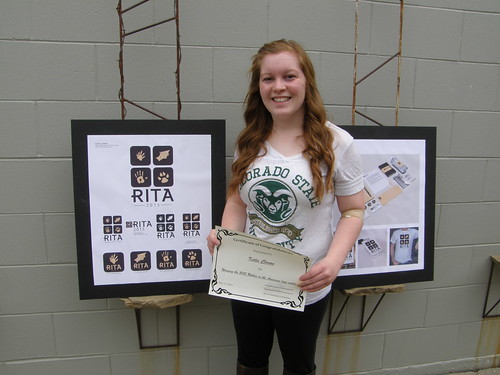
Come this October, Katie Clonan is looking forward to seeing the fruits of her labor all over Fort Collins, Colorado. That’s because Katie is the winner of the 2015 Rabies in the Americas (RITA) logo contest. Her logo will be showcased on t-shirts, banners, and other paraphernalia shared with more than 300 attendees of the 26th annual RITA conference from October 4-8 in Fort Collins.
“This is the first time the international Rabies in the Americas conference has been held in Colorado,” notes Dr. Stephanie Shwiff, one of several USDA-Animal and Plant Health Inspection Service (APHIS) National Wildlife Research Center (NWRC) scientists helping to plan the event. “We’re excited to host the conference with our colleagues in the Wildlife Services National Rabies Management Program and other members of the RITA planning committee. One of my favorite tasks so far has been partnering with Colorado State University’s (CSU) Department of Art and Art History to sponsor a logo contest.”
As part of their spring semester course in illustration, more than thirty CSU graphic design students each created a logo for use on conference promotional materials. Katie, a junior Fine Arts major, won the contest including a $500 prize donated by the RITA planning committee. Her simple, elegant design includes silhouettes of paw prints, a bat wing, and a human hand. Colorado State University is managing the conference and everything, including the prize money and the logo items, will be paid for from attendee registration fees and sponsor donations.
“Given this is an international conference and attendees work on a variety of rabies issues, I wanted to make sure that each attendee could relate to the logo in some way. I not only drew inspiration from the animals affected by rabies, but also the human side of the story,” notes Katie. “I learned so much during this process about rabies and how it still impacts people around the world. I wanted my design to reflect that.”
The annual RITA meeting has grown in popularity and prominence since its start in 1990 with delegates now coming from more than 20 countries across five continents. The meeting provides an opportunity for researchers, health professionals, rabies program managers, wildlife biologists, laboratory personnel, and other people interested in advancing knowledge about rabies surveillance, prevention and control, to meet, share their successes, and discuss challenges.
Rabies in domestic animals and wildlife is a concern in many areas around the world. In the United States, wildlife accounts for approximately 92 percent of all reported rabies cases. In other areas, such as in Mexico and South America, rabies is still prevalent in dogs and bats.
Over 60,000 people worldwide die from rabies each year.
To learn more about USDA’s work related to rabies, please visit the following:
